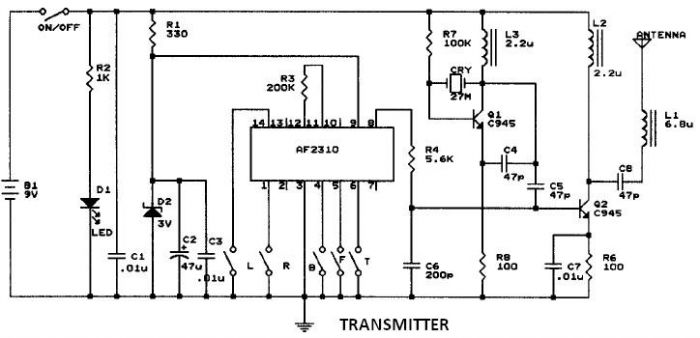
hardware control with computer

When the water level is low, the wires in the tank are open-circuited, and the 180K resistor pulls the switch low, resulting in the switch opening and the LEDs turning OFF. As the water begins to fill the tank, the wire connected to S1 and the positive supply is shorted by the water, which closes switch S1 and turns LED1 ON. As the water level continues to rise, LEDs 2, 3, and 4 light up sequentially. When the tank is full, the water pulls the base of the BC148 transistor high, saturating it and activating the buzzer. The SPST switch must be opened to turn the buzzer OFF. This circuit, utilizing a 555 timer IC, can serve as an alarm system to deter theft of luggage or prevent burglaries. The alarm activates when a thin wire, approximately the thickness of a hair, is broken. The circuit is simple, employing a 555 IC configured as an astable multivibrator to generate a tone at about 1 kHz, producing a shrill sound to scare off intruders. It should be positioned at an angle of 30 to 45 degrees to the ground to ensure rainwater drains away, preventing false alarms from accumulated water. The sensor material should be aluminum instead of copper, as copper develops a blue oxide layer when exposed to moisture, requiring regular cleaning. The first IC (left) is set to operate at around 1 Hz, with a 47 µF capacitor that charges and discharges periodically, causing the voltage across it to fluctuate. This configuration generates a sound reminiscent of a factory siren, using a 555 timer IC as an astable multivibrator with a center frequency of about 300 Hz. The frequency is adjusted via pin 5 of the IC. Upon power activation, the capacitor charges slowly, altering the voltage at pin 5 and gradually increasing the frequency. Once the capacitor is fully charged, the frequency stabilizes. Pressing the siren control switch causes the capacitor to discharge, resulting in a decrease in siren frequency. The presets VR1 and VR2 should be fine-tuned for optimal performance. This anti-theft alarm FM radio control can be utilized in any vehicle with a 12-volt DC power supply. The mini VHF, FM transmitter is installed in the vehicle overnight when parked. The CXA1019 receiver, based on a single module IC, is available at reasonable prices and remains inside the vehicle. The receiver is tuned to the transmitter's frequency, and when the transmitter is active, the FM radio receiver outputs no hissing noise. Consequently, transistor T2 (BC548) remains inactive, allowing transistor T3 to receive base bias through a 10 kΩ resistor (R5), energizing the relay. If an intruder attempts to drive the car away, the radio link between the vehicle (transmitter) and the alarm (receiver) is interrupted, generating hissing noise from the FM radio module. This hissing AC signal is coupled to the relay switching circuit via an audio transformer. The AC signals are then rectified and filtered by diode D1 and capacitor C8, producing a positive DC voltage that forward biases transistor T2. This causes transistor T2 to conduct, pulling the base of relay driver transistor T3 to ground, thereby activating the relay that disables the alarm connected through the normally closed relay contact. If the intruder disconnects the battery, the alarm remains functional since the absence of the signal continues to generate hissing noise at the receiver's output. Thus, the burglar alarm is both foolproof and reliable. The brake light bulb flasher is essentially a modified flashing circuit designed to turn a bulb on and off instead of an LED, utilizing a 555 timer IC configured as an astable multivibrator.When the water is empty the wires in the tank are open circuited and the 180K resistors pulls the switch low hence opening the switch and LEDs are OFF. As the water starts filling up, first the wire in the tank connected to S1 and the + supply are shorted by water.
This closes the switch S1 and turns the LED1 ON. As the water continues to fill the tank, the LEDs2, 3 and 4 light up gradually. When the water is full, the base of the transistor BC148 is pulled high by the water and this saturates the transistor, turning the buzzer ON. The SPST switch has to be opened to turn the buzzer OFF. This circuit utilising a 555 timer IC can be used as an alarm system to prevent the theft of your luggage, burglars breaking into your house etc.
The alarms goes ON when a thin wire, usually as thin as a hair is broken. The circuit is straightforward. It uses a 555 IC wired as an astable multivibrator to produce a tone of frequency of about 1kHz which gives out a shrill noise to scare away the burglar. It has to placed making an angle of about 30 - 45 degrees to the ground. This makes the rain water to flow through it to the ground and prevents the alarm from going on due to the stored water on the sensor.
The metal used to make the sensor has to be aluminium and not copper. This is because copper forms a blue oxide on its layer on prolonged exposure to moisture and has to be cleaned regularly. The first IC (left) is wired to work around 1Hz. The 47uF capacitor is charged and discharged periodically and the voltage across it gradually increases and decreases periodically.
This circuit produces a sound similar to a factory siren. Uses a 555 timer Ic used as an astable multivibrator of a center frequency of about 300Hz. The frequency is controlled by the pin 5 of IC. When supply is turned on, the capacitor charges slowly and this alters the voltage on pin 5 of IC so the frequenct increases gradually. After the capacitor is fully charged, the frequency no longer increases. Now when the switch button siren control is pressed, the capacitor discharges and the siren frequency also decreases.
The presets VR1 and VR2 should be adjusted for optimum performance. This anti-theft alarm FM radio-control can be used with any vehicle having 6 - with the power supply 12 volt DC. The mini VHF, FM transmitter is installed in the vehicle at night when parked in the car porch or car park.
CXA1019 receiver with a single module IC-based FM radio, which is freely available on the market at reasonable prices, remains inside. The receiver is tuned to the frequency of the transmitter. When the transmitter is on and the signals are being received by FM radio receiver, no hissing is available at the output of the receiver.
Thus transistor T2 (BC548) does not hold. This results in the driver transistor T3 getting its relay forward base bias via 10k resistor R5 and the relay is energized. When an intruder tries to drive the car and takes a few meters from the driveway, the radio link between the car (transmitter) and alarm (receiver) is broken.
As a result FM radio module gene-rates hiss. Hissing AC signals are coupled to relay switching circ-uit via audio transformer. These AC signals are rectified and filtered by diode D1 and C8 capacitor and the resulting positive DC voltage provides a forward bias of transistor T2. Thus transistor T2 conducts, and pull the base of relay driver transistor T3 to ground level. The relay which disables the alarm connected via N / C relay is on. If, by chance, the intruder learns the wireless alarm transmitter and disconnect the battery, the alarm is still remote, because in the absence of the signal, the receiver continues to produce hissing noise at its output.
So the burglar alarm is foolproof and reliable. Brakelight bulb flasher This is basically a modified flash circuit on and off a bulb instead of LED. Use a 555 timer IC working as an astable multivibrator. The blink rat 🔗 External reference
This closes the switch S1 and turns the LED1 ON. As the water continues to fill the tank, the LEDs2, 3 and 4 light up gradually. When the water is full, the base of the transistor BC148 is pulled high by the water and this saturates the transistor, turning the buzzer ON. The SPST switch has to be opened to turn the buzzer OFF. This circuit utilising a 555 timer IC can be used as an alarm system to prevent the theft of your luggage, burglars breaking into your house etc.
The alarms goes ON when a thin wire, usually as thin as a hair is broken. The circuit is straightforward. It uses a 555 IC wired as an astable multivibrator to produce a tone of frequency of about 1kHz which gives out a shrill noise to scare away the burglar. It has to placed making an angle of about 30 - 45 degrees to the ground. This makes the rain water to flow through it to the ground and prevents the alarm from going on due to the stored water on the sensor.
The metal used to make the sensor has to be aluminium and not copper. This is because copper forms a blue oxide on its layer on prolonged exposure to moisture and has to be cleaned regularly. The first IC (left) is wired to work around 1Hz. The 47uF capacitor is charged and discharged periodically and the voltage across it gradually increases and decreases periodically.
This circuit produces a sound similar to a factory siren. Uses a 555 timer Ic used as an astable multivibrator of a center frequency of about 300Hz. The frequency is controlled by the pin 5 of IC. When supply is turned on, the capacitor charges slowly and this alters the voltage on pin 5 of IC so the frequenct increases gradually. After the capacitor is fully charged, the frequency no longer increases. Now when the switch button siren control is pressed, the capacitor discharges and the siren frequency also decreases.
The presets VR1 and VR2 should be adjusted for optimum performance. This anti-theft alarm FM radio-control can be used with any vehicle having 6 - with the power supply 12 volt DC. The mini VHF, FM transmitter is installed in the vehicle at night when parked in the car porch or car park.
CXA1019 receiver with a single module IC-based FM radio, which is freely available on the market at reasonable prices, remains inside. The receiver is tuned to the frequency of the transmitter. When the transmitter is on and the signals are being received by FM radio receiver, no hissing is available at the output of the receiver.
Thus transistor T2 (BC548) does not hold. This results in the driver transistor T3 getting its relay forward base bias via 10k resistor R5 and the relay is energized. When an intruder tries to drive the car and takes a few meters from the driveway, the radio link between the car (transmitter) and alarm (receiver) is broken.
As a result FM radio module gene-rates hiss. Hissing AC signals are coupled to relay switching circ-uit via audio transformer. These AC signals are rectified and filtered by diode D1 and C8 capacitor and the resulting positive DC voltage provides a forward bias of transistor T2. Thus transistor T2 conducts, and pull the base of relay driver transistor T3 to ground level. The relay which disables the alarm connected via N / C relay is on. If, by chance, the intruder learns the wireless alarm transmitter and disconnect the battery, the alarm is still remote, because in the absence of the signal, the receiver continues to produce hissing noise at its output.
So the burglar alarm is foolproof and reliable. Brakelight bulb flasher This is basically a modified flash circuit on and off a bulb instead of LED. Use a 555 timer IC working as an astable multivibrator. The blink rat 🔗 External reference





